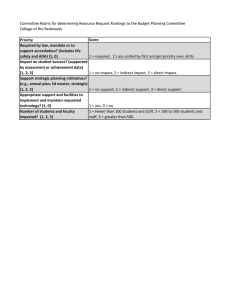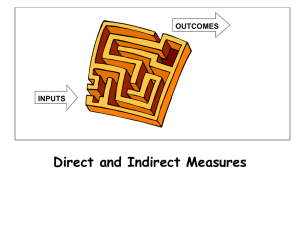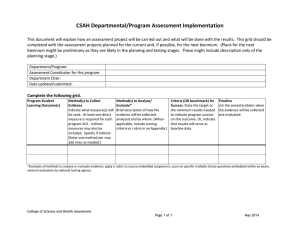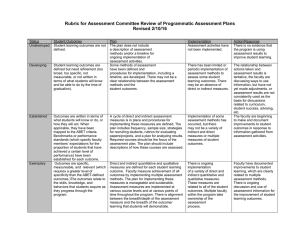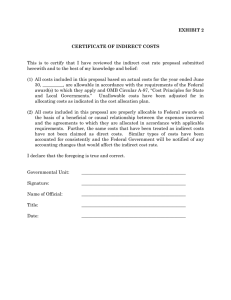Document 15991790
advertisement
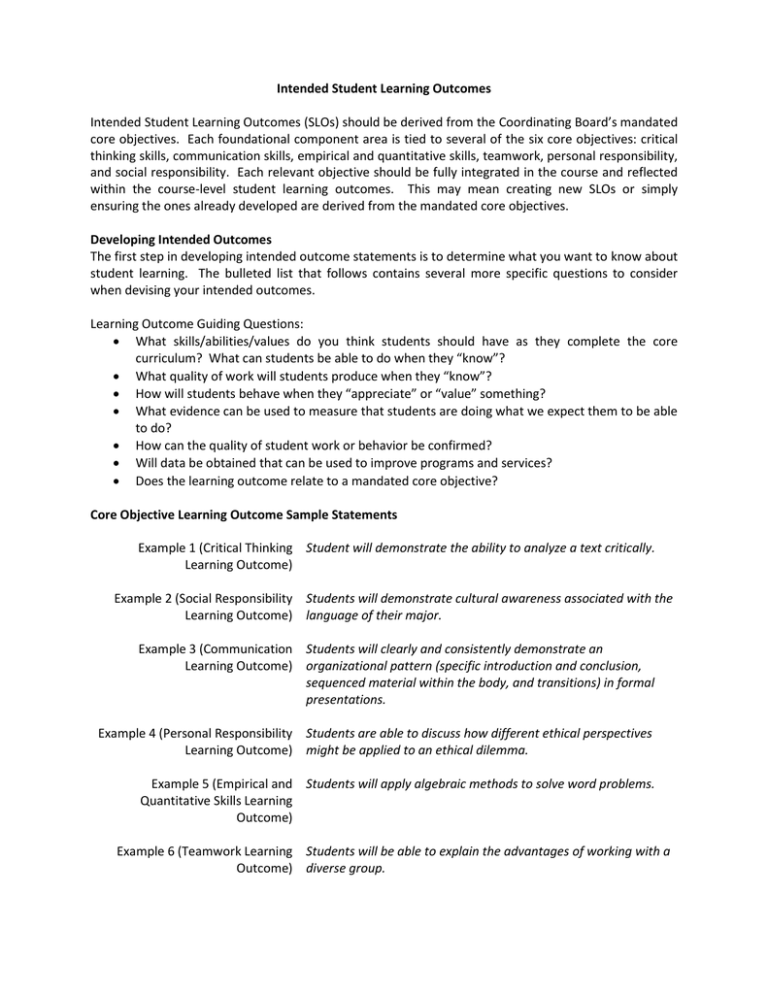
Intended Student Learning Outcomes Intended Student Learning Outcomes (SLOs) should be derived from the Coordinating Board’s mandated core objectives. Each foundational component area is tied to several of the six core objectives: critical thinking skills, communication skills, empirical and quantitative skills, teamwork, personal responsibility, and social responsibility. Each relevant objective should be fully integrated in the course and reflected within the course-level student learning outcomes. This may mean creating new SLOs or simply ensuring the ones already developed are derived from the mandated core objectives. Developing Intended Outcomes The first step in developing intended outcome statements is to determine what you want to know about student learning. The bulleted list that follows contains several more specific questions to consider when devising your intended outcomes. Learning Outcome Guiding Questions: What skills/abilities/values do you think students should have as they complete the core curriculum? What can students be able to do when they “know”? What quality of work will students produce when they “know”? How will students behave when they “appreciate” or “value” something? What evidence can be used to measure that students are doing what we expect them to be able to do? How can the quality of student work or behavior be confirmed? Will data be obtained that can be used to improve programs and services? Does the learning outcome relate to a mandated core objective? Core Objective Learning Outcome Sample Statements Example 1 (Critical Thinking Student will demonstrate the ability to analyze a text critically. Learning Outcome) Example 2 (Social Responsibility Students will demonstrate cultural awareness associated with the Learning Outcome) language of their major. Example 3 (Communication Students will clearly and consistently demonstrate an Learning Outcome) organizational pattern (specific introduction and conclusion, sequenced material within the body, and transitions) in formal presentations. Example 4 (Personal Responsibility Students are able to discuss how different ethical perspectives Learning Outcome) might be applied to an ethical dilemma. Example 5 (Empirical and Students will apply algebraic methods to solve word problems. Quantitative Skills Learning Outcome) Example 6 (Teamwork Learning Students will be able to explain the advantages of working with a Outcome) diverse group. You may also want to consider using Bloom’s taxonomy to further guide your efforts. The Task Oriented Question Construction Wheel graphic below includes the levels within Bloom’s Taxonomy; recommended verbs to use when developing learning outcome statements; and activities students can perform to demonstrate their level of learning. The next step after drafting your student learning outcomes is to ask three additional questions: Is the outcome meaningful or useful for a required core objective? Will the results of assessing the outcome render data that have practical significance or usefulness that help you know if the students have achieved what they are supposed to from the course? If not, will you be able to use the assessment data to improve pedagogy and subsequently student learning? Is the outcome measurable? Is the intended outcome specific enough to assess one aspect of a single core objective? Will there be a course artifact that demonstrates the students’ knowledge or skill identified in the intended outcome statement? Is the outcome manageable? Can the intended outcomes be measured by the completion of the course? Is the measurement of the intended outcome within the means of the unit doing the assessment? Determining Assessment Methodology The criteria below should be thoroughly considered when choosing an assessment strategy: 1. Consider the reliability of the assessment method. Reliable measures are ones that produce consistent results through time. Measurement errors can occur through the individuals responding, through the administration and scoring of the instrument and through the instrument itself. Some errors can be minimized or avoided by insuring that the instrument is well written and without ambiguity. 2. Consider the validity of the instrument. Validity refers the instrument’s ability to measure what we want it to measure. Are we measuring what we say we are measuring? 3. Consider the significance of the data that will be produced. Will the data that will be produced be good enough to use for decisions and improvement? Is the data going to be useful for making improvements at the unit level (as opposed to improvements that must be made on a larger scale)? While you are considering the essential criteria above, make sure you keep close at hand the methodological “musts” listed below. The selected methodology has to meet each of these essential points (as applicable). 1. Assessment methodology must evaluate the extent to which the Intended Outcome is achieved, not whether the Action Steps were or were not completed. 2. Assessment methodology intended to measure student learning must examine a student work product (student performance in response to a specific project, assignment, knowledge test, etc.). This is referred to as using a direct measure of student learning. Indirect measures can be used to support the data derived from the direct measure. The table below lists examples of direct and indirect types of assessment methods. 3. Assessment methodology for learning outcomes must utilize objective information (based on direct measures) and not rely solely on self-reports or other subjective information, which are referred to as indirect measures (see below for samples of indirect measures). If indirect measures are used to measure student learning, then they must be accompanied by a direct measure. Direct Measure Examples Indirect Measure Examples Exams (National; Pre-test/Post-test; Licensure, etc.) Surveys of Attitudes Portfolios Interviews Juried Activities Focus Groups Grading Rubrics Questionnaires Practical exams Graduation and retention rates Research papers, thesis & dissertations Graduate follow-up studies Exhibitions and demonstrations Job placement data Oral exams or presentations Curriculum and syllabus analysis Because measurement in education is not an exact science, it is a good idea to identify more than one method of assessment for each intended outcome. Finding that two assessment methods produce similarly positive (or negative) results lends some degree of validity for the results and conclusions drawn from those results. This is especially true when using indirect methods. Using multiple measures to increase the degree of validity is referred to as triangulation of data. Example 1: Student Learning Outcome: Student will demonstrate the ability to analyze a text critically. Direct Assessment Method: Students taking ENGL 10XX will write a paper critically analyzing a selected text. An external expert (or experts) will review a sample of student work by utilizing a departmentally developed rubric, which identifies students’ areas of strengths and weaknesses. Department faculty will review the resulting reports to determine how many students met the criteria of success. For the outcome to be considered achieved, 90% of papers assessed must score “Proficient” or “Distinguished” in at least three of the four elements of critical analysis. Example 2: Student Learning Outcome: Students will demonstrate cultural awareness associated with the language of their major. Direct Assessment Method 1: 85% of students will earn a 90% on the cultural awareness portion of a departmentally developed final exam covering written, oral, and cultural awareness competencies. Departmental personnel will administer the exam. Departmental faculty will review test results to determine any needed curricular changes. Indirect Assessment Method 2: All students enrolled in the course will maintain weekly journals. Journal entries will consist of student reactions to course content and student perceptions of progress toward course objectives. Instructors will examine the student journals for evidence of language proficiency and cultural awareness. Departmental faculty will review the instructors’ findings to determine curricular strengths and weaknesses. Sources of Assessment Measurements When devising measures for your intended outcomes consider what your unit may already be doing that could be used or modified for assessment purposes. Potential measurement tools could be group projects, lab assignments, or licensure exams. In academic units, using already existing student assignments, projects, and exams is often referred to as embedded assessments. In-house developed tools generated by faculty can be efficient, informative and cost effective. In your search for an appropriate and effective assessment methodology, you are likely to encounter rubrics or the suggestion to devise a rubric for assessment purposes. More information about rubrics can be found throughout the internet, but you may want to begin with the rubric resources in the UEP Assessment Handbook. Establishing the Criteria for Success The criterion for success is the benchmark or target that serves as an indicator for accomplishment. Criteria for success should be concrete levels of achievement based on the measures employed through the assessment tool. These targets are established during the planning process prior to implementation of the methodology. Units should consider the use of primary and secondary criteria for success (Nichols & Nichols, 2000). The primary criteria for success are the overall levels of success and the secondary criteria are the detailed levels of success that contribute to the overall level of success. As an example, consider the assessment of a written composition. The primary criterion may be that 90% of students are able to compose a ‘Good’ to ‘Excellent’ essay. The secondary criteria may be that 85% students are to perform at a level of ‘Good’ to ‘Excellent’ in each area of a composition including composition, grammar, use of references, etc. University of Texas at Arlington Core Curriculum Course-based Assessment Plan Template School/College Department Assessment Plan for YEAR Assessment Plan Contact Name: Contact Phone Extension: Contact Email: Core Curriculum Foundational Component Area: Core Objective: Intended Student Learning Outcome: (Must be derived from required core objectives and there must be at least one student learning outcome for each objective.) Methodology : Describe the planned assessment activity or how assessment will be done including: What kind of direct assessment will be used (e.g., a multiple-choice test, a short answer test, quizzes)? How often will the data be collected? If only a sample of students’ work will be used, please describe how sampling will be done. Criteria for success: Timeline: Responsible Persons: (Who will collect data? Who will analyze data? Who will report the data? Please indicate individual(s) by title, not name.)
